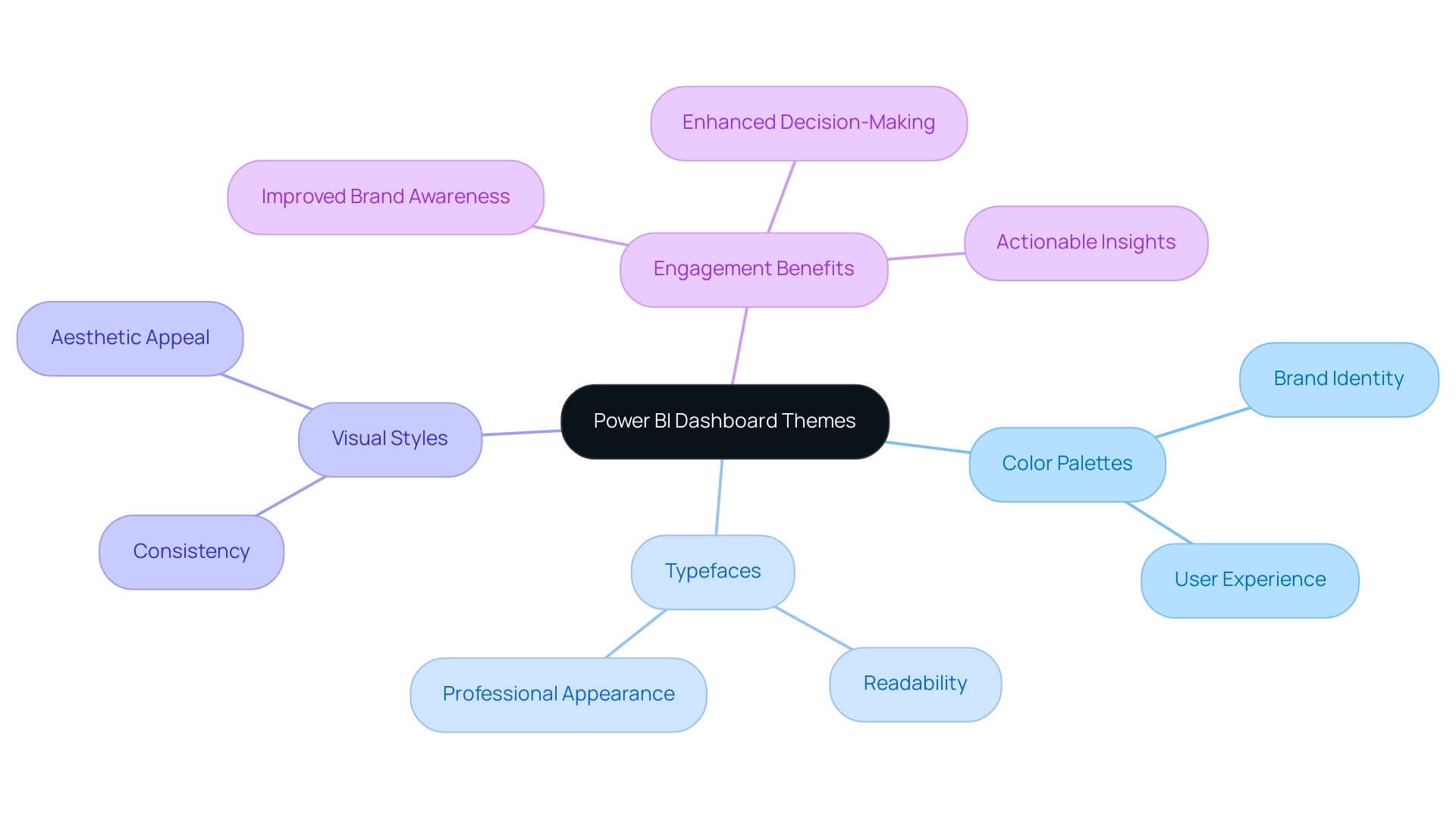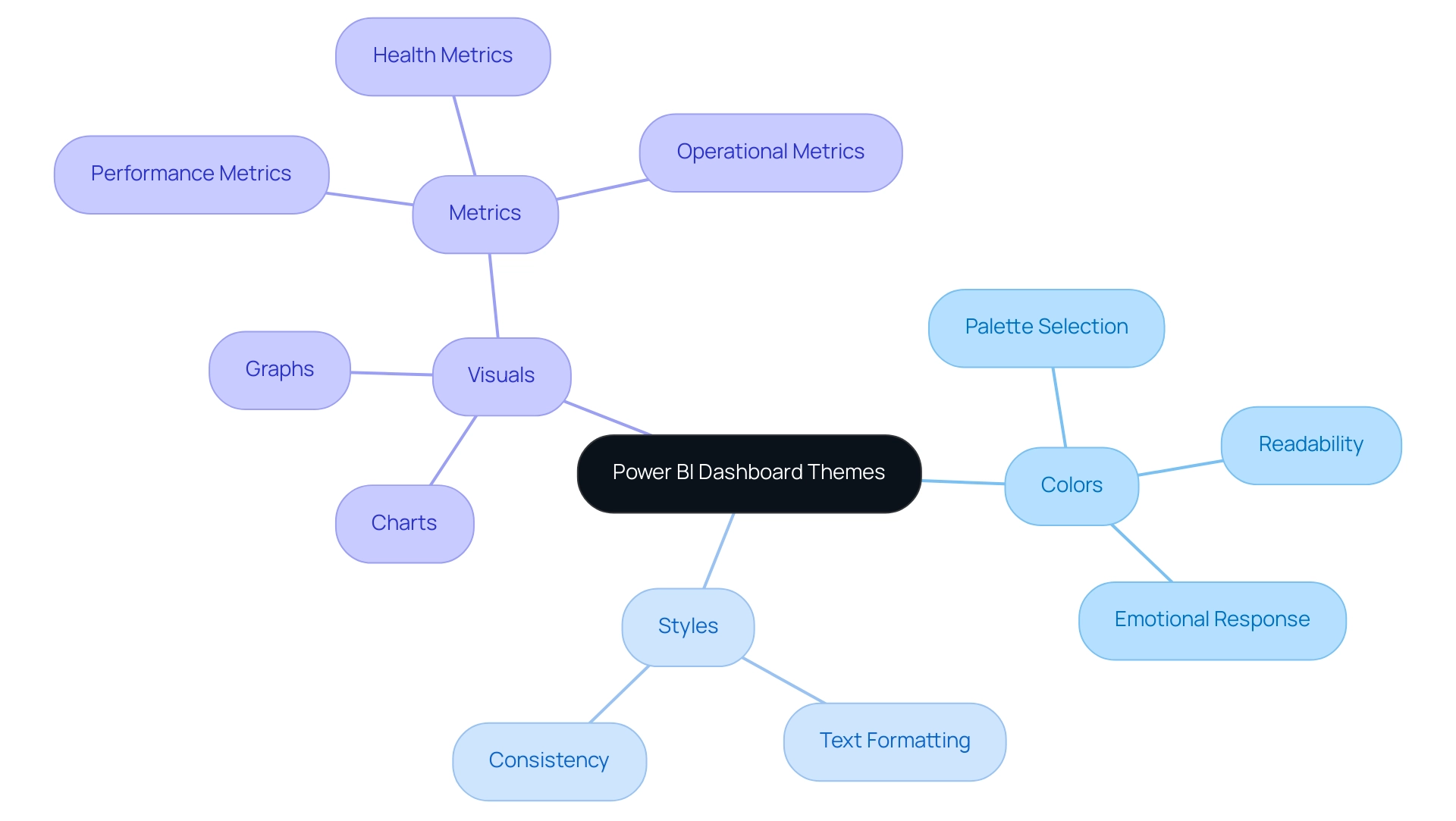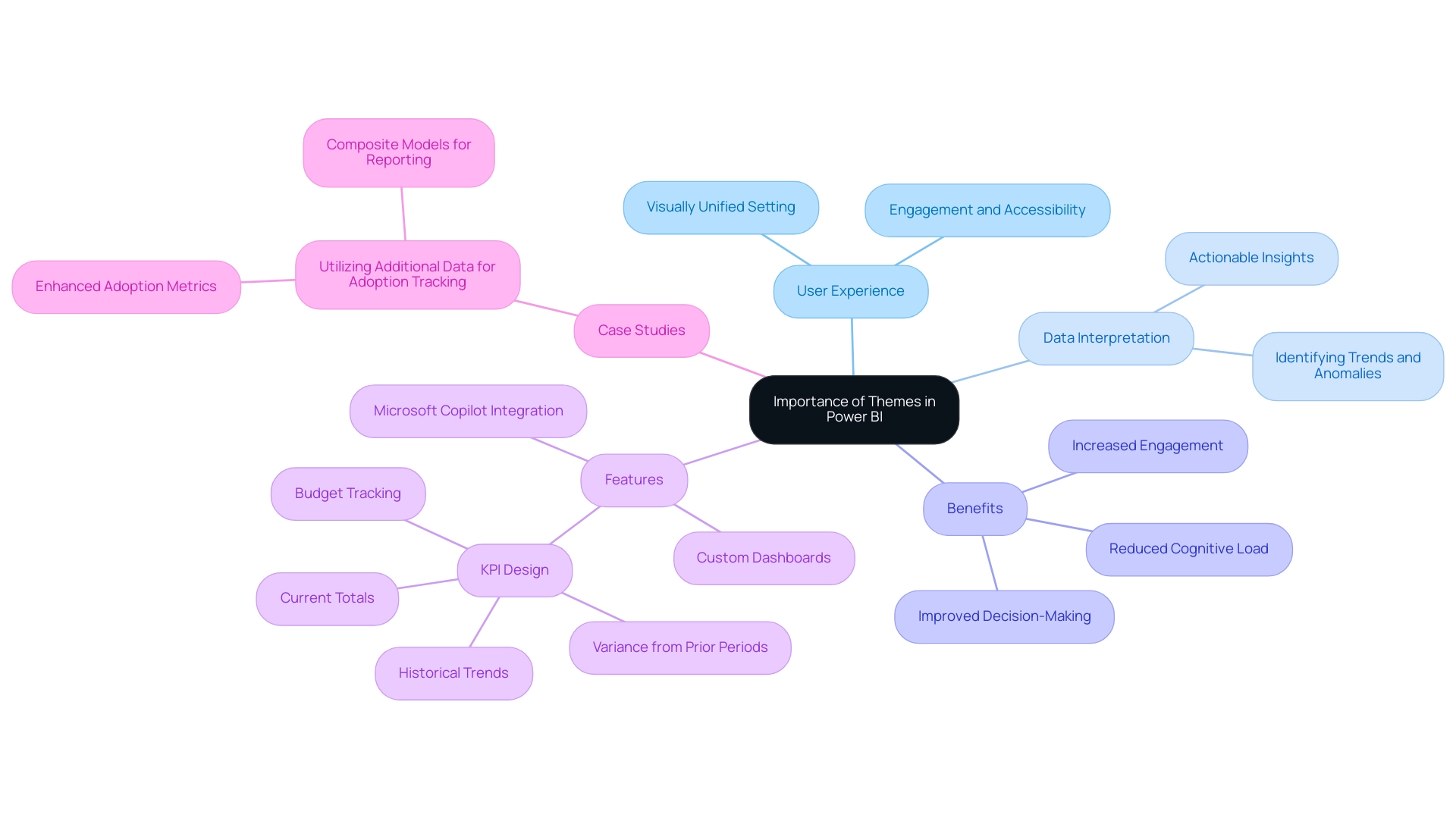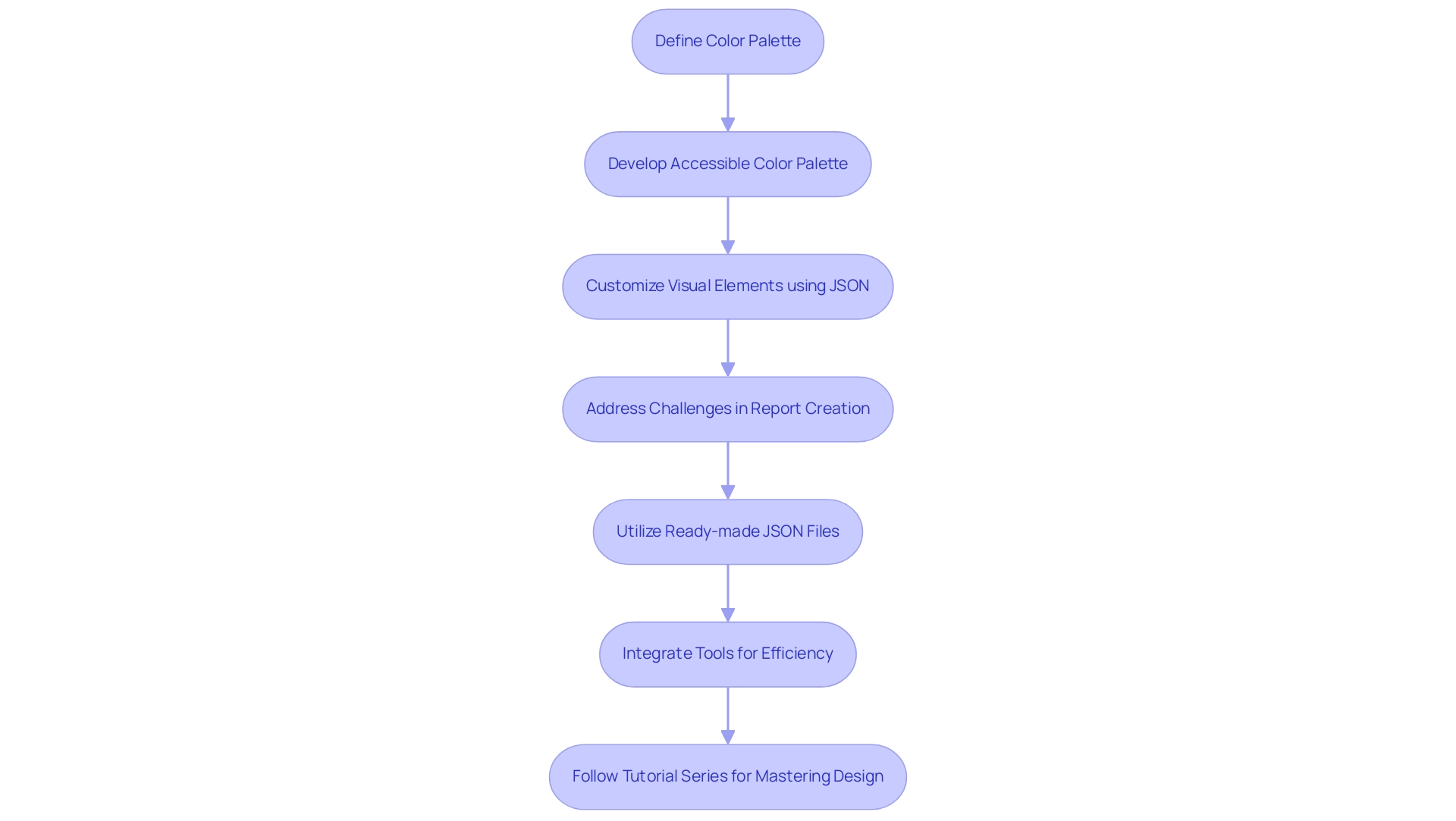Introduction
In the dynamic world of data visualization, Power BI dashboard themes emerge as a powerful tool for organizations striving to enhance their reporting capabilities. These themes not only provide a framework for consistent visual aesthetics but also address critical challenges such as time-consuming report generation and data inconsistency.
By carefully selecting colors, styles, and visuals, businesses can create an engaging user experience that fosters better data interpretation and decision-making. As organizations seek to optimize their dashboards, understanding the importance of these themes becomes essential for driving operational efficiency and elevating brand identity.
This article delves into the intricacies of Power BI dashboard themes, offering actionable insights and best practices to empower users in their quest for impactful data visualizations.
Defining Power BI Dashboard Themes: An Overview
The power bi dashboard theme visual styles act as essential groups of formatting configurations that influence the overall appearance of reports and displays within the Power BI ecosystem. These concepts include components such as color palettes, typefaces, and visual styles, which allow organizations to create a unified and professional look throughout their power bi dashboard theme and other visual representations. By utilizing these themes, companies not only improve brand awareness but also develop interfaces that are more engaging and intuitive for individuals, addressing common challenges like time-consuming report generation and information inconsistencies arising from a lack of governance strategy.
In a landscape where participant engagement, as indicated by total report viewers across the workspace, can significantly impact data interpretation and decision-making, the importance of actionable guidance cannot be overstated. The General Management App offers comprehensive management solutions, Microsoft Copilot integration, and predictive analytics, which can seamlessly integrate with Power BI to enhance the functionality of logistics dashboards. Specifically, it offers actionable insights that assist individuals in their decision-making processes, thereby enhancing report efficiency.
As noted by Adeline, a Helper III, “Here is a good resource for Power BI marketing templates, containing analysis for Google Ads, Facebook, LinkedIn, Amazon, HubSpot, and many others.” Combining these resources can assist organizations in applying efficient concepts, enhancing information display, and elevating the overall experience for individuals. This engaging and accessible method highlights the practical use of concepts in crafting displays that enhance participant involvement, making it crucial for organizations aiming to improve their data-driven strategies.

Key Components of Power BI Dashboard Themes: Colors, Styles, and Visuals
The foundational elements of the Power BI dashboard theme encompass colors, styles, and visuals, each serving a distinct purpose in effective information communication. Color selections are crucial, as they not only improve readability but also elicit specific emotions and responses from individuals. A well-organized palette can greatly enhance engagement by directing focus to essential information, tackling the frequent issues of time-consuming report creation and inconsistencies.
As Carlos Nisbet aptly notes,
We need to apply some logical rules that give us scope; so we opted for tints and shades of our primary and accent colors therefore giving us flexibility whilst containing the five palette colors.
Styles are equally essential, involving the formatting of text and other elements to ensure clarity and consistency throughout the interface. Meanwhile, visuals denote the collection of charts and graphs employed to showcase information, simplifying the interpretation of intricate details.
Various kinds of metrics, such as performance, health, and operational metrics, play a vital role in shaping the design of these displays, ensuring that key information is highlighted effectively. The case study titled ‘Better Interface Design with Audience Research’ emphasizes the significance of audience feedback in crafting interfaces that connect with individuals by presenting pertinent, clear, and succinct information. Furthermore, the BBC’s accessibility interface serves as a real-world example of effective design, featuring high-contrast mode and keyboard navigation, enhancing engagement and accessibility.
By carefully choosing and coordinating these elements, individuals can create a Power BI dashboard theme that not only engages visually but also promotes informed decision-making and efficient information analysis. Moreover, integrating RPA solutions like EMMA RPA and Power Automate can significantly boost operational efficiency by automating repetitive tasks and enhancing information accuracy. To explore how these tools can transform your business, book a free consultation today.

The Importance of Themes in Enhancing User Experience and Data Interpretation
Themes in Power BI dashboard themes are essential for improving experience and information interpretation. They design a visually unified setting, allowing individuals to explore intricate information sets effortlessly. By addressing common challenges such as time-consuming report creation and inconsistencies, thoughtfully designed themes significantly reduce cognitive load.
This enables individuals to concentrate on extracting actionable insights instead of sorting through a mishmash of styles. Implementing features from the General Management App—like Microsoft Copilot integration and custom dashboards—can streamline seamless data integration and provide expert training. These enhancements not only lead to improved adoption rates but also render dashboards more engaging and accessible.
For instance, utilizing contrasting colors for key performance indicators helps individuals in swiftly identifying trends and anomalies, thereby accelerating the decision-making process. Moreover, effective concepts can direct users on the subsequent actions to undertake based on the information provided, addressing the significant absence of practical advice frequently encountered. With the organization currently achieving a maturity level of 200 in executive sponsorship and aiming for 500, the effective use of the Power BI dashboard theme is crucial in reaching these goals.
As Kenneth Leung states, ‘Discover how Power BI can be leveraged to generate high-impact visualizations and narratives to drive scalable, evidence-based decision making in your organization.’ Additionally, addressing governance strategy issues, such as ensuring consistent data presentation across reports, is essential for building trust in the data. Case studies such as ‘Utilizing Additional Data for Adoption Tracking‘ demonstrate how organizations can enhance their adoption tracking efforts through effective implementation, ultimately improving clarity and driving scalable, data-driven decision-making throughout their operations.

Creating and Implementing Custom Themes in Power BI
The process of creating and implementing a Power BI dashboard theme significantly enhances your reports, ensuring they not only reflect your organization’s brand identity but also drive operational efficiency. To begin, individuals should define a color palette that resonates with their branding standards, as emphasized by designer Paul Waller, who highlights the importance of accessibility in data visualization. By developing an accessible color palette, particularly for individuals with color vision deficiencies, organizations can promote inclusivity in their reporting.
Utilizing JSON files, Power BI users can effectively customize various visual elements, such as colors and fonts, to create a Power BI dashboard theme that meets the needs of diverse audiences. This customization not only enhances visual appeal but also strengthens brand identity across all reports and dashboards. For those encountering challenges in report creation, such as time-consuming processes, inconsistencies, and the competitive disadvantage of not utilizing meaningful insights, Creatum offers the 3-Day Power BI Sprint.
In just three days, we will create a fully functional, professionally designed report on a topic of your choice, allowing you to focus on utilizing actionable insights for impactful decision-making. Additionally, Power BI provides a variety of ready-made custom report theme JSON files, including the Waveform theme and Color-blind friendly theme, which enhance the Power BI dashboard theme by improving accessibility and personalization. Embracing these resources empowers users to create impactful, inclusive visualizations while driving business growth and innovation.
Furthermore, integrating tools like EMMA RPA and Power Automate can streamline processes, reduce task fatigue, and enhance operational efficiency, addressing the challenges of data extraction and report generation. For assistance, a tutorial series named ‘Mastering Design in Power BI’ is scheduled to debut on March 24, 2024, offering step-by-step directions for applying these concepts and customization methods.

Best Practices for Designing Effective Power BI Dashboard Themes
Creating effective Power BI dashboard themes requires adherence to several best practices that enhance both visual appeal and usability, ultimately contributing to improved operational efficiency. Consistency is essential; employing a cohesive color palette and uniform typography fosters a polished and professional appearance that assists in interpretation. It is crucial to choose colors that promote readability, particularly for users with color blindness, ensuring that the information is accessible to all.
Understanding the cultural implications of color is vital; as highlighted in the case study titled ‘Cultural Considerations in Color Usage,’ colors can have different meanings across cultures—red, for instance, can signify danger in Western cultures but prosperity in Eastern contexts. This awareness can help in designing visualizations that resonate universally and drive actionable insights. Furthermore, before creating a visualization, it is essential to consider the information being presented and the tools or platforms used for building the visualization.
Utilizing sequential color palettes improves interpretation; lighter colors usually represent lower values while darker shades signify higher ones, aligning with the need for clarity in reporting. To illustrate, Amy Bower, a Senior Scientist at Woods Hole Oceanographic Institute, states,
frequency mapping, when low tones match with low numbers and high tones represent high numbers, is an effective way to depict information without a graph.
Involving end-users for feedback on themes encourages ongoing enhancement based on their preferences, resulting in more functional and impactful displays.
Additionally, integrating RPA solutions can further enhance operational efficiency by automating repetitive tasks, thereby reducing task fatigue and streamlining processes. For instance, tools like EMMA RPA and Microsoft Power Automate can assist organizations in automating information collection and reporting processes, significantly decreasing the time devoted to manual tasks. By implementing these best practices and utilizing RPA tools, organizations can craft visually striking and efficient dashboards with a Power BI dashboard theme that effectively convey critical insights, overcoming the challenges of time-consuming report creation and data inconsistencies, ultimately driving business growth.

Conclusion
The effective utilization of Power BI dashboard themes is a game changer for organizations aiming to enhance their data visualization and reporting capabilities. By defining a cohesive aesthetic through careful selection of colors, styles, and visuals, businesses can not only improve brand recognition but also create engaging and intuitive dashboards that facilitate better decision-making. The implementation of these themes addresses common challenges such as time-consuming report generation and data inconsistencies, ultimately streamlining the reporting process and boosting operational efficiency.
Moreover, the importance of user feedback and accessibility cannot be overstated. Themes that are designed with inclusivity in mind ensure that all users can interpret data effectively, regardless of their visual abilities. This commitment to accessibility, combined with best practices in design, empowers organizations to create dashboards that resonate with their audience and drive actionable insights. As organizations continue to refine their data-driven strategies, leveraging custom themes becomes essential for fostering user engagement and enhancing the overall user experience.
In conclusion, embracing Power BI dashboard themes is not just about aesthetics; it’s about operational excellence and informed decision-making. By following best practices and utilizing available resources, organizations can craft impactful, visually appealing dashboards that not only capture attention but also enhance clarity and understanding of complex data sets. The journey toward effective data visualization begins with the right themes, setting the stage for a future of data-driven success.

